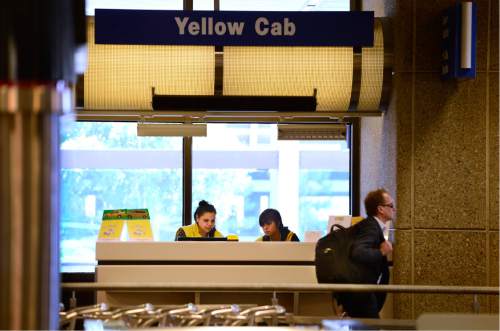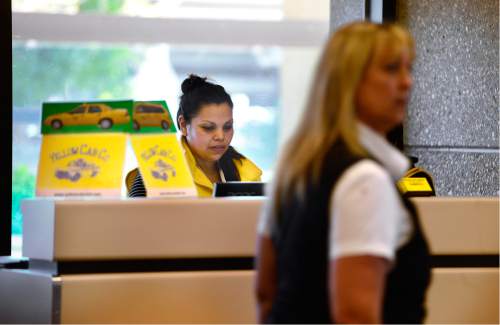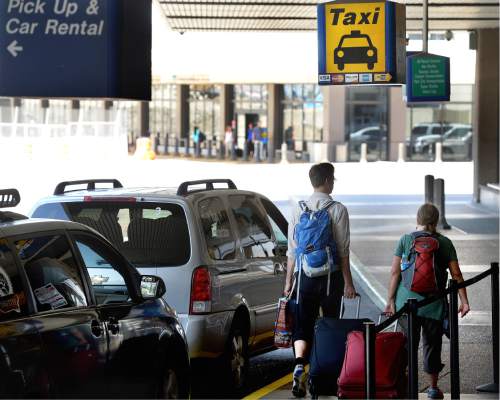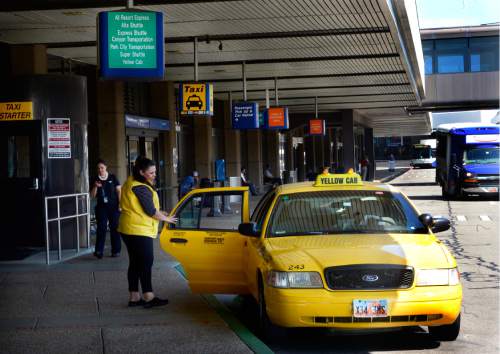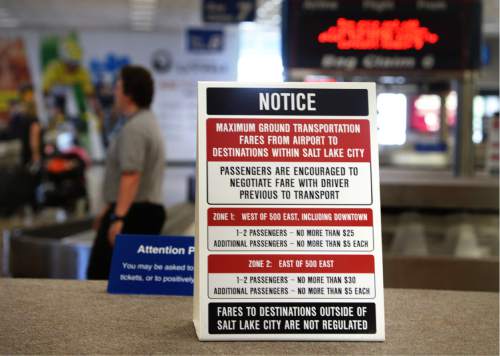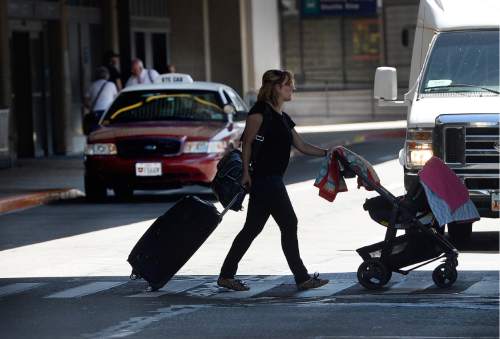This is an archived article that was published on sltrib.com in 2016, and information in the article may be outdated. It is provided only for personal research purposes and may not be reprinted.
Not long ago, the only three cab companies in Salt Lake City were Ute, City and Yellow — and only they could use the taxi stands at Salt Lake City International Airport.
All three have now abandoned those city-operated stands — refocusing efforts elsewhere, such as at downtown hotels. They still go to the airport to pick up people who call, and Yellow opened booths inside the terminals where people may request its cabs.
They all say they were essentially crowded out of the city stands by the 433 other small taxicab companies formed after deregulation tied to the arrival of ride-hailing companies Uber and Lyft. Heavy competition now makes cabbies wait up to four hours for a fare from those airport stands.
"It's just a waste of time," said City Cab co-owner Bruce Jackson. "We never sit out there now."
As allowed by deregulation, those newer companies generally do not use meters, can charge almost any amount they want and need not disclose fares until arrival. They are not required to accept credit cards nor offer receipts.
"It's the wild, wild West out there," said Ute Cab President Ken Olsen. "There's just too many people sitting. There's hundreds of them every day waiting to get a fare. They get maybe four a day. It's hard to make a living that way."
The three traditional cab companies — which say they still use meters and charge the same rates as always — blame city deregulation for long waits for fares and for complaints of price gouging by cabs using airport stands.
"A large percentage of them are people who could not get hired, or were fired, from cab companies for doing things they shouldn't be doing," Abel Aratyunyan, dispatch manager for Ute, said. "The city made them all legitimate now. The airport has created that mess."
Airport spokeswoman Nancy Volmer sees it differently.
"Ground transportation is more competitive now with more approved providers. This means more choices for passengers, higher-quality vehicles and better service," she said.
—
Price gouging • The Salt Lake Tribune reported last month about stacks of complaints filed with the city since deregulation a year ago, filled with tales of price gouging by cabs using stands where city-contracted employees help assign riders to cars.
For example, one woman was charged $200 for a ride to Cottonwood Heights; several passengers paid $25 to airport hotels less than two miles away; one was charged $132 to Park City (which had cost him $85 previously); another paid $160 to go to Snowbird (double earlier rates).
Two of the many complaints were about gouging by Yellow Cab drivers not using meters. Company manager Mark Hatch said they were not following company policy, and cabs now have signs telling passengers that meter use is required. Ute and City did not have written complaints filed against them in the months after deregulation.
The city scrapped most cab regulations after the Legislature passed a bill allowing ride-hailing services such as Uber and Lyft in most places, and the City Council followed up with ordinances to allow them at the airport.
For ground-service companies, the city now requires only a business license, verification of insurance, a safety inspection and a criminal-background check for drivers. With that, they may use airport taxi stands.
They are not required to use meters and have few limits on fares.
"They totally deregulated ground transportation in Salt Lake, which wasn't done anywhere, not only in the United States, but in the world that I am aware of. So they made it a free-for-all out there," complains Ute's Olsen.
But airport spokeswoman Volmer said, "The ground-transportation climate is changing nationally. The entrance of Uber and Lyft in the market has changed transportation on a number of levels, and Salt Lake is no exception."
Complaints from passengers about service and price gouging have actually decreased in recent months, she said, because "Uber and Lyft began operating in the city in fall 2015 and limited rate restrictions have been implemented."
When some cabbies started charging high fares in 2015, Airport Executive Director Maureen Riley took advantage of a law that allows her to address emergency conditions. She said the lack of regulated rates created an "emergency," and she used it to impose maximum fares of $25 for taxi rides west of 500 East, and $30 within the city beyond that.
No limits exist for fares outside city limits. The airport posted signs warning of the situation, urging people to negotiate final fares before entering a cab.
—
Some meters • Yellow, Ute and City cab companies say they continue to charge metered fares, as always.
"We could change anything we want to. We won't do it," Olsen said. "We've been here since 1952. We're here for the long haul. We've built a business based on trust, and we're not about to throw that out the door because we are able to charge any amount we want to charge."
Hatch had a similar take.
"We try to be honest and give people value for what we charge them. ... We've never really gone off the billing system: It's $2.25 for a flag drop and $2.20 a mile after that."
But airport spokeswoman Volmer said poor performance by traditional taxicab companies is what spurred the city to make changes with airport ground transportation.
"The airport used to receive frequent complaints about long wait times, dirty and old vehicles and problems with drivers when the traditional taxicab companies were operating at the airport," she said.
—
Long queues • Olsen said that before deregulation, cabbies could make a good living working at the airport because it allowed only 25 taxis to line up at a time — and let individual drivers work there only every other day to spread around the business.
After deregulation, he said, cabbies were parking everywhere possible at the airport to try to get in line. So the airport eventually reinstated its rule for no more than 25 in line at the curb.
Others queue up at a ground-transportation staging lot until a space opens at the curb, Volmer said.
But that lot also is often full. So cabbies each now pay $30 a month to a private lot off airport property at the now-closed Diamond Lil's restaurant on North Temple, said Doug Park, owner of East Coast Transportation, a smaller cab company.
"It sometimes is a four-hour wait to get a fare," he said, adding he believes that leads some to overcharge passengers to help defray the costs of waiting.
Park, a former longtime driver for Ute, is a critic of many of the smaller new companies. Customers often complain to him about being gouged by other cabs, or of drivers borrowing passengers' smartphones to figure out how to reach their destinations.
The airport doesn't "care if you know what you are doing," Park said. "They just want to flood the city with so many cars that it's just unbearable for everybody, and nobody can make a living because you have too many cars."
—
Moving on • The three traditional companies say they once depended on the airport for a third or more of their business, but, amid the hundreds of competitors, that is now a fraction of what it once was. Meanwhile, the airport says Uber and Lyft have captured a third of the market there.
Ute and City now generally go to the airport only when called.
Yellow, however, bid for and received two booths by baggage-claim areas "for a lot of money," Hatch said.
It staffs those booths with people who will call and arrange for cabs, but says the city does not allow it to advertise its prices at the airport, and people must go to booths for information.
He figures it costs $150,000 or more a year just for its "taxi starter" employees at Yellow's booths, but is necessary to keep generating business and avoid the long queues for city-operated taxi stands.
"But gypsy cabs don't pay for the starters at the city's stands. Who does? The city is paying for them. I think it gives an unfair financial advantage to the gypsy cabs," Hatch said.
Aratyunyan, with Ute, said, "I just want people to know there is another option" besides waiting for cabs at the city-operated stands — and people can still call for the traditional companies and their metered cabs.
"I want the public to know that we are here. We haven't changed," he said.
Meanwhile, Volmer encouraged travelers to be smart consumers.
"Passengers need to know that the traditional metered system is rarely used in Salt Lake City [now] and [they] are encouraged to check with the driver upfront regarding fees."


